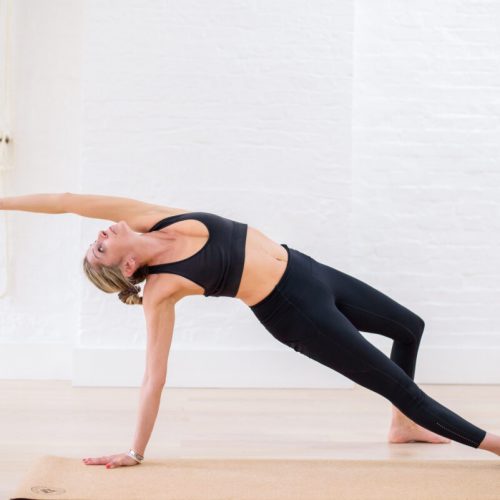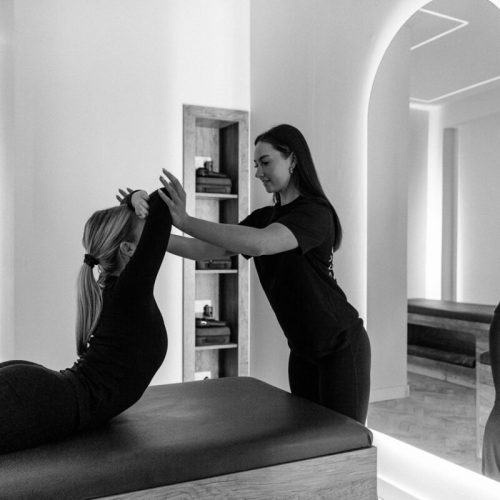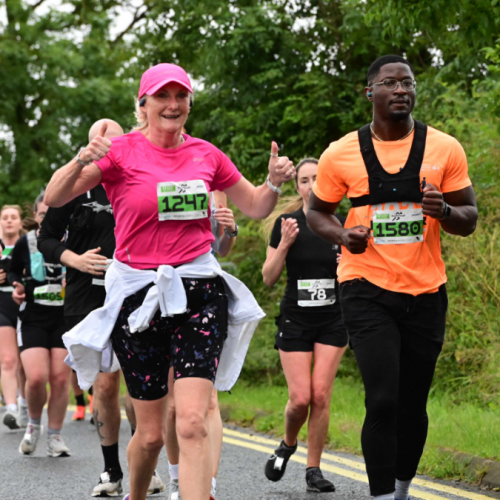Sharing her tips and tricks, Content and Creative Designer, Issy, ran her first-ever half marathon thanks to Hoka. The Hackney Half hosted a record number of 25,000 runners which brought thousands of people to decent to East London to show their support. Following rigorous training in the lead-up, Issy reveals everything she learnt, plus the things that made race day run smoothly!
Follow a training plan
It’s all well and good just going out and running, but when it comes to training for a race, you need to have a proper programme in place. Ultimately, it’s about gradually building up your distance but there are other training modalities that can be interspersed to advance your running. Intervals, tempo runs, easy runs and long runs are added into the mix to map a strategic programme that is going to get to prepared to race day! A brilliant tool to help with this is Runna, nominated as the #1 rated running app for good reason. Offering customisable running plans, the app is an accessible and affordable way to follow a programme created by top-class running coaches. Another important part of a programme is the taper in the week leading up to race day, Runna will include the taper into the plan so you know when it’s time to start toning it down.
Fuel is crucial
I’ve always been someone that trains first thing in the morning on an empty stomach, but as I got into my half-marathon training I quickly realised that fuel in the tank is essential when you’re racking up the miles. Overnight oats are my go-to pre-run fuel, the slow energy release from the carbs keeps me going for ages. I avoid coffee at all costs (it gives me the jitters) but I never go without Innermost’s Energy Booster before a run, it’s a clean pre-workout with added BCAAs…aka rocket fuel! On my longer runs, I use energy gels, something I was completely new to and a little apprehensive about. I did my research and saw tons of runners raving about Maurten gels over on Instagram and Tiktok. Unlike other gels that are bound with sugary syrups, these gels are made up of a biopolymer matrix which is incredible for providing energy and contains no added colourants, preservatives or flavours. When I saw that Eliud Kipchoge is a fan, I ordered a box, and boy oh boy did they deliver. During my half, I took two gels, one at 7km and the other at 14km. I tend to ingest the gel over some time to let it settle in my stomach, rather than slurping up the whole lot in one gulp. They’re no bother to hold as you run around, and this way you avoid getting a stitch. They give me a massive burst of energy and also structure my run, it felt like a mile point getting to my final gel and gave me that push I needed.
Rest up
You’ve heard it before, but I’ll say it again. Rest and recovery will be your best friend throughout training. My schedule during the week varies, some days I’m up at 5:15am and others I can lie in until 8am. I quickly learnt that there was little to no point running on the days I was having less sleep. My performance was poor and the runs were unenjoyable. Getting in at least 8 hours is essential on long-run days. I typically aimed for 9 hours of sleep before my long run day (once per week) which is a luxury I know not everyone has, but even if you’re not actually sleeping, try to rest!
Warm-up
A fully, structured warm-up is not only going to help you perform better, but also help stay injury free. The warm-up routine I developed over my training period followed as so-
5 mins mobility drills- flowing movements to limber up (be sure to include ankle mobility)5 mins glute activations – Use a resistance band to switch on your glutes to avoid pain in the knees, hips and lower back when running5 mins dynamic movement- explosive drills to get the heart rate up and prep the body
Hydration
You lose a lot of water when you run, so hydrating pre and post-workout is super important…basically, you want to be very aware of how much water you’re drinking through the whole of your training. When I say pre-workout, I don’t mean just before you set off, you’ll be trying to find the first toilet en route if you drink lots of water just before your run. You want to be hydrating in the lead-up to your runs rather than immediately prior. I was making a conscious effort to consume about 3 litres of water a day in the week leading up to race day, especially as the forecast was set for around 22 degrees and pure sunshine. In my training, I didn’t run with water as the gels do provide hydration and it was never particularly warm or sunny during this time BUT that said running with water is definitely a good thing for a lot of runners. Get yourself a Camelbak hydration vest for convenience! Most race events provide hydration stations on the route which I made full use of during my half marathon, I grab 3 cups which I took a small swig from on the course and it really revived me! Be sure you check what you grab though, I made the mistake of picking up an energy drink by accident, which of course spilt all over me as a drink would when you’re consuming while running…my arm was then all sticky for the remainder of the race which was very unpleasant!
Kit
It goes without saying that good kit is a must. Go for running-specific gear over normal gym kit. There’s no ‘one size fits all’ when it comes to trainers, in more ways than one. Our biomechanics are uniquely individual, and the best way to find the shoe with the right tread, cushioning and support is to do pattern analysis (you can get these done at most decent running stores) or if you have a rough idea of whether you’re an overpronator or an underpronator, look for shoes that are specifically designed for this. I ran my half marathon in the Hoka Bondi 8’s which were both comfortable, supportive and responsive. Hoka’s website gives you a rundown of the shoe as well as tech specifics with every nano detail explained from the heel-to-toe drop to the spring measurement. Go for proper running socks to avoid blisters as well! In terms of clothing, I ran in Lululemon Wunder Train High-Rise Short with Pockets 8″ as the length is ideal to avoid chaffing but will still keep you cool and they also have two side pockets for easy access to gels, phone, etc! A high-impact bra is important for obvious reasons, especially if you have bigger boobs, the Lululemon High Support Energy Bra is a winner. I went for a light, breezy Hoka Short Sleeve Top which is moisture-wicking and has an underarm gusset to avoid armpit chaffing. Another top tip is to run with a hat if it’s hot, SPF is likely to sweat off so the hat will keep you protected and does a great job of stopping sweat from your head trickling down your forehead, likewise, if it’s raining they keep your vision clear.
Check the course
Hundreds of races take place across the UK, so choose your course wisely! I would avoid anything that involves laps, the repetition tends to get very boring. Another element to review before booking a race is the elevation. A hilly route is no easy feat, some are up for the challenge, others not, just make sure you know what you’re getting yourself into. Boston Marathon is considered one of the most challenging races, if you’ve conquered it, my hat goes off to you! The Hackney Half has an elevation gain of 65m which isn’t too bad. There was one hill towards the very end that was killer but bar that, it was pretty smooth sailing.
Support
Having friends and family dotted throughout the course gave me an indescribable boost! I was lucky enough to spot my nearest and dearest at three different points at around 4 miles, 12 miles and on the final stretch at 13 miles. My brother popped up waving at 12 miles as a total surprise (he lives in Newcastle), I really needed a surge of energy at this point and this spurred me on and even reduced my split for the final km’s, I even shed a few tears in utter disbelief! Another amazing thing my friends and family decided to do was to spread out down the final stretch, so for around 200m I was cheered on to get me over the finish line…it was an unforgettable moment! If you don’t have friends and family coming to support you, make sure you have your name displayed on your top, that way people may cheer out your name on route. Also, try to book a race that has a good atmosphere, the Hackney Half is notoriously great for this with thousands lining the streets to support! Of course, the London Marathon is the pinnacle of UK races but I’ve also heard great things about the London Landmarks Half, the Royal Parks Half and the Great North Run!
Motivating tunes
I always have and always will listen to music when I run. It keeps me motivated and gives an incredible ‘runners high’ when a good song strikes at the perfect moment! I opt for high-BPM songs that enable me to hit the beat with every stride, it truly transformed my pace as I was so in time with the music. Spotify is filled with high BPM playlists to listen to, typically drum and bass music has a fast tempo that works well.
Leave plenty of time
Get to your event with lots of time to spare as anything could happen and there’s nothing worse than getting flustered before a big race, or worse, missing the event you’ve spent months prepping for. Factor in all the things that could possibly go wrong, transport links, toilet and bag drop queues, road closures, and congestion getting into the starting place. I had major issues with the overground trying to get to Hackney Marshes, all the trains were packed with runners sardined in, so I attempted to book an Uber which was a waste of time as the surrounding roads were closed. I finally resorted to riding a HumanForest E-Bike, what a godsend they are!
Stay positive
The final tip that I’m going to share is to stay positive, throughout your training and throughout race day! I found reciting mantras very inspiring, as cheesy as it may sound, these are some of my favourites that got me through the rough patches-
Great things come from stepping out of your comfort zoneYou are capable of amazing thingsThis is tough, but so are you
Also, note that not every single run will go as planned, some days will be harder than others, sometimes you push through and get the miles done, others you turn around a go home…and that is ok. The most important thing is to reset and go again when you can, don’t give up when the going gets tough because as said above, great things come from stepping out of your comfort zone.
Post-race
It’s tempting to sit or lay down immediately after you run but try to resist and gently walk it out to cool down. Once your heart rate has gradually decreased, carry out a sequence of stretching to avoid being stiff the following day. It’s important to note that it is very important throughout training as well as, so you can stick to your programme without experiencing horrific DOMs! Once the big race is over, take a second to let it all sink in, the hard work is over and the endorphins will be flying high! I soothed my problematic knee by rubbing in the PureSport CBD Muscle & Joint Balm in the days following, as well as slathering my (worst-for-wear) feet in the Margaret Dabbs London Foot Hygiene Cream in an attempt to revive the skin.
words by Isabelle Shury
The post “12 Things I Learnt Running My First Half Marathon” appeared first on Hip & Healthy.


